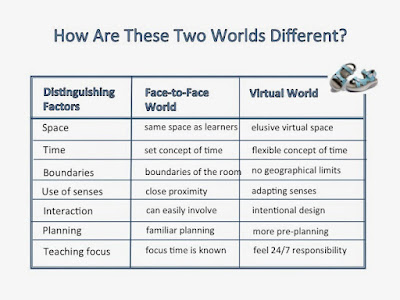
What types of experience can you use for learners to help create a sense of presence? We’ve identified four types: subjective, objective, social, and environmental experiences. These types of experiences are based on concepts addressed by Ijsselsteijn et al. (2000).
Subjective experience is personal and psychological presence and takes place within our mind. It is the illusion of being in another location. For example, when our learners are experiencing online learning, they may have the illusion of being in another location as their mind is interacting with the content, you (the instructor), and other learners.
Objective experience gives you and your learners a sense that you are both psychologically and physically in another location (Ijsselsteijnet al., 2000). It’s like feeling that you are "actually" located in the technology-mediated space. Objective experience has occurred in our teaching. Our learners have said that they experienced a feeling of psychologically and physically being in the same space with others during an online class - that they felt like they were in the same room and that the technology had disappeared. In reality, they were separated by thousands of miles.
Social experience is when you have a sense of being with others who exist in the online environment and respond to each other. It is the social presence derived from communicating and interacting with others or with animated characters; for example, interacting with avatars in Second Life®. When others recognize and respond, it validates both the individual and group existence. The importance of ongoing interactions is significant and allows and facilitates feelings of understanding (Hargreaves, 2004).
Environmental experience views the learner as a partner and central to the design process. It provides the ability to easily access and modify the environment (Sheridan, 1992), provide input about the environment, and interact with that environment. A description of the environmental experience incorporates both the physical and the educational aspects of the learning experience. The physical aspect involves the capability for the learners to have technical access and support for the technology and tools they are using. The educational aspect is the instructor’s openness and the design of the course structure that allows learners to feel that they are an integral part of the environment and can react to it.
References
Hargreaves, A. (2004). Emotional geographies of teaching. Teachers College Record,103(6), 1056–1083.
Ijsselsteijn, W. A., de Ridder, H., Freeman, J., & Avons, S. E. (2000). Presence: Concept, determinants, and measurement. In Human Vision and Electronic Imaging Conference, proceedings of the International Society for Optical Engineering, 3959, 520–529.
Sheridan, T. (1992). Musings on telepresence and virtual presence. Telepresence. Presence: Teleoperators and Virtual Environments, 1(1), 120–126.























